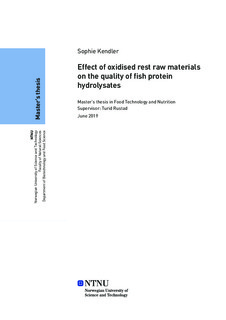| dc.description.abstract | The growing world population demands a solution for the utilisation of rest raw materials from primary production. There is a huge potential to make aquaculture and fishery more sustain- able in the various application of rest raw materials from catches. Especially in Norway, where the fishing industry has a long tradition, it is of great importance to investigate sustainable and future orientated solutions for marine by-products. Studies on achieving a full protein recovery of fish rest raw materials have been a main focus in the past years. Fish protein hydrolysates deliver a high amount of easily digestible proteins and have a good nutritional value as well as functional properties.
In this study, fish protein hydrolysates made out of trout heads were investigated. The aim of the thesis was to study the effect of oxidised rest raw materials on the quality of fish protein hydrolysates. The raw material varied in its oxidative status and was either fresh, oxidised or oxidised with added antioxidant. The raw material and the thereof produced hydrolysates were analysed. To evaluate the properties and quality of the rest raw material and hydrolysates, differ- ent parameters were determined. These include the determination of protein content, molecular weight distribution, total and free amino acid composition, soluble and acid-soluble proteins, collagen as well as the determination of the degree of hydrolysis. Ultramembrane filtration was performed and molecular weight distributions as well as water solubility was performed on the retentates and permeates of the hydrolysates.
All hydrolysate samples showed a high content of essential amino acids and high solubility, thus exhibiting a high nutritional value and digestibility. The combination of the good nutri- tional value and high solubility of the proteins lead to the conclusion that the hydrolysates are a good source of dietary proteins. Furthermore, the results of the degree of hydrolysis and acid- soluble peptides showed no significant difference between the samples. The molecular weight distribution of the hydrolysates showed a high amount of small sized peptides and the ultra- membrane filtration lead to two fractions of peptides.
The results show, that the overall quality of the hydrolysates are influenced by the oxidation status of the raw material. No linear correlation was found between oxidative status and free amino acid concentrations, but a correlation between degree of hydrolysis and free amino acid content of three out of the four hydrolysate samples was found. The linear correlation was found in the three samples, that were hydrolysed using the same hydrolysis condition. The hy- drolysate, where the antioxidant was added directly into the hydrolysis tank, did not fit in the correlation. This indicates that the time of adding the antioxidant plays a crucial role for the outcome and quality of the hydrolysate. Furthermore, a correlation between oxidation indica- tors and protein solubility of three of the four hydrolysates was observed. It was found that a higher oxidation in the raw material leads to a decreased solubility in the hydrolysates, but does not necessarily mean a high oxidation in the hydrolysates. This implicates, that the ongoing oxidation process of not correctly stored rest raw material does not have a negative effect on the nutritional value of the hydrolysates, but changes the digestibility of proteins. | |
